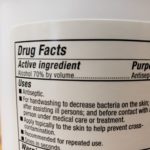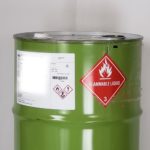Because of the ongoing COVID-19 public health emergency, the Pipeline and Hazardous Materials Safety Division within the U.S. Department of Transportation (USDOT/PHMSA) is providing temporary relief from the Hazardous Materials Regulations (HMR) for the manufacturers and subsequent transporters of alcohol-based Hand Sanitizers made under specific FDA guidance.
The purpose of this article is to identify and explain the requirements of the USDOT/PHMSA Temporary Policy for the Transportation of Certain Alcohol-Based Hand Sanitizer Products During the Public Health Emergency (COVID-19).
Updates:
The first version of this relief was published 04.02.20. A revised version – the one this article is based on – was released 04.10.20. It may be updated and/or revised again as the situation changes. I will try to update my information as soon as I am aware of a change but please use caution when reading any information in these rapidly-changing times. Please refer directly to the USDOT/PHMSA website for the most current information.
UPDATE: June 24, 2020 USDOT/PHMSA announced an extension of this relief until October 31, 2020.
ANOTHER UPDATE: December 7, 2020 USDOT/PHMSA announced a notice of reinstatement and extension of this relief until March 31, 2021 under specified conditions
Read: Notice of Reinstatement and Extension of Enforcement Policy Regarding Hand Sanitizers
USDOT/PHMSA realized that as of 10.31.2o there would still be a lot of hand sanitizer in warehouses packaged and prepared to be shipped under the conditions of the Temporary Relief Policy. To facilitate a continued response to the COVID-19 public health emergency, USDOT/PHMSA allows for its transportation under the following conditions:
- Hand sanitizer was manufactured and packaged prior to October 31, 2020.
- Hand sanitizer was packaged in accordance with the previous Notices of Enforcement Discretion. (The requirements of those previous Notices of Enforcement Discretion are explained in this article).
- Hand sanitizer must be offered for transportation and transported prior to March 31, 2021.
Before we begin…
As described further in the Scope and Applicability section, this policy and the relief it offers is only available within the U.S. under the authority of the USDOT/PHMSA. Neither of the following international transportation agencies have – at the time of this writing – offered any relief from their regulations for dangerous goods transportation.
- International Air Transportation Association (IATA) has relaxed its regulations for Hand Sanitizer as a dangerous good for passengers and crew but nothing for cargo.
- International Maritime Organization (IMO) has not offered any relief from full regulation for the transportation of Hand Sanitizer as a dangerous good.
The HMR already contains exceptions from full regulation for the transportation of Class 3 Flammable Liquids. Some of those existing exceptions may already apply to your transport of Hand Sanitizer, making the use of this relief unnecessary. Read: Shipping Hand Sanitizer During the COVID-19 Public Health Emergency
Note:
Centers for Disease Control and Prevention (CDC) recommends consumers use an alcohol-based hand sanitizer that contains at least 60% ethanol or 70% isopropanol. |
The Temporary Policy uses only the U.S. Standard for units of measure (e.g., gallons) instead of providing measurements in both U.S. Standard and the International System of Units (SI or metric) as is done throughout the HMR. Read: Units of Measure Used in the Hazardous Materials Regulations
Alcohol-based Hand Sanitizers usually contain from 60% to 70% ethyl alcohol or isopropyl alcohol. Under the HMR at 49 CFR 173.120 they will typically be classified as a Class 3 Flammable Liquid due to a flash point of 60 °C or less (≤140 °F).
Scope and Applicability:
- USDOT/PHMSA is providing this relief to companies producing Hand Sanitizer under FDA Guidance to address the current COVID-19 public health emergency and companies that subsequently transport the Hand Sanitizer. Terms used in the HMR to describe those persons subject to this relief are as follows:
- Shipper prepares the Hand Sanitizer for transportation and/or offers it for transportation to the carrier.
- Carrier transports the Hand Sanitizer on a public roadway to its destination.
- The relief is temporary. It expires three (3) months from its date of issuance of April 10, 2020. So, expiration is July 10, 2020, or until the public health emergency is over, whichever is sooner. UPDATE: June 24, 2020 USDOT/PHMSA announced an extension of this relief until October 31, 2020. Read: Notice of Extension of Temporary Policy for the Transportation of Certain Alcohol-Based Hand Sanitizer Products During the COVID-19 Public Health Emergency
- This relief applies only to Hand Sanitizer transported by highway within the U.S., and does not apply to transportation by air, vessel, or rail. Specifically, the relief applies to Hand Sanitizer transported by private, common, or contract carriers by motor vehicle.
- Hand Sanitizer eligible for this relief may only contain one of the following at a concentration of no more than 80%:
- Ethyl alcohol
- Isopropyl alcohol
- All packagings of alcohol-based Hand Sanitizer offered for transport and transported under the conditions of this relief (this includes combination and single packagings, small or larger quantities) must be:
- Leak tight.
- Securely closed.
- Secured against shifting.
- Protected against damage.
Daniels Training Services, Inc. 815.821.1550 |
USDOT/PHMSA will not take enforcement action for violations of the HMR if these procedures are followed.
For Small Quantity of Hand Sanitizer in Combination Packaging of no More Than Eight (8) Gallons Capacity
- Hand Sanitizer is packed in combination packaging.
- Inner packaging(s) do(es) not exceed one (1) gallon capacity.
- Outer packaging does not exceed a capacity of eight (8) gallons.
- Combination packaging is defined at §171.8:
Combination packaging means a combination of packaging, for transport purposes, consisting of one or more inner packagings secured in a non-bulk outer packaging. It does not include a composite packaging.
- Inner packaging(s) are secured and cushioned within the outer packaging to prevent breakage, leakage, and movement.
- Inner packaging(s) are packed with package closures in an upright orientation.
Q: So, eight (8) one-gallon plastic packagings of Hand Sanitizer packed securely in a fiberboard box is OK under this relief?
A: Yep.
- The combination package may itself or with other packages be combined into an overpack. Overpack is defined at §171.8:
Overpack, except as provided in subpart K of part 178 of this subchapter, means an enclosure that is used by a single consignor to provide protection or convenience in handling of a package or to consolidate two or more packages. Overpack does not include a transport vehicle, freight container, or aircraft unit load device. Examples of overpacks are one or more packages:
(1) Placed or stacked onto a load board such as a pallet and secured by strapping, shrink wrapping, stretch wrapping, or other suitable means; or
(2) Placed in a protective outer packaging such as a box or crate.
Note: Overpack is an important part of the packaging requirements for a small quantity of Hand Sanitizer in a single packaging (see next).
- The following must be printed on the outside of the combination package and, if applicable, the overpack:
- Company name.
- “Sanitizer – Contains Ethyl Alcohol” or “Sanitizer – Contains Isopropyl Alcohol”
Or…
- The FDA label shown in Appendix A through D of the FDA Guidance if it is visible in transportation.
And that’s it! A shipper or carrier in compliance with the above need not comply with the remainder of the HMR. But sometimes you need more Hand Sanitizer…
Contact me with any questions you may have about the transportation of hazardous materials by air, highway, vessel, or rail International and Domestic Daniels Training Services, Inc. 815.821.1550 |
For Small Quantity of Hand Sanitizer in Single Packaging of More Than one (1) Gallon Capacity
- Hand Sanitizer is packed in a single packaging. Single packaging is defined at §171.8:
Single packaging means a non-bulk packaging other than a combination packaging.
- The single packaging may have a capacity of more than one (1) gallon but may not exceed eight (8) gallons.
- The single package must be overpacked in one of the following:
- Crate
- Cage
- Cart
- Box
- Similar overpack
Note: The use of “overpack” here is limited to the type of overpack identified in (2) of the definition and not (1), (see above). The type of overpack required here is one that is a protective outer packaging and not simply held onto a board with shrink wrap.
- Package (single package in overpack) is then secured in the transport vehicle to prevent breakage, leakage, and movement.
- Packages are packed with package closures in an upright orientation.
- The following must be printed on the outside of the single package and the overpack:
- Company name.
- “Sanitizer – Contains Ethyl Alcohol” or “Sanitizer – Contains Isopropyl Alcohol”
Or…
- The FDA label shown in Appendix A through D of the FDA Guidance if it is visible in transportation.
And that’s it! A shipper or carrier in compliance with the above need not comply with the remainder of the HMR. But sometimes you need more Hand Sanitizer…
For Larger Quantity of Hand Sanitizer in Packaging of More Than Eight (8) Gallon Capacity
- The type of packaging for the Hand Sanitizer is not specified. However, the introduction to this part refers to, “…drums or other packagings”. It is presumed this part of the relief is for a single packaging.
- Packaging may have a capacity of more than eight (8) gallons but must not exceed 119 gallons. This then, is a non-bulk packaging.
- Packaging is DOT or United Nations (UN) specification packaging.
- Packaging meets Packing Group II (PG II) performance standard. A UN standard packaging meeting the PG II performance standard must be display either “X” or “Y” for its performance Code.
- Packaging is identified as an authorized packaging at §173.202.
- Shipper must close the packaging according to closure instructions provided by the packaging manufacturer or distributor.
- The package displays the label for Class 3 Flammable Liquid (see §172.419).

- Packages must be secured in the vehicle to prevent breakage, leakage, and movement during transportation.
- Transportation must be in a vehicle under exclusive use for such service.
- A shipping paper or bill of lading is prepared and accompanies the packages of Hand Sanitizer in transportation. At a minimum the shipping paper contains the following information:
- Basic description: UN1987, Alcohols, n.o.s., Class 3, PG II
- Number, type, and capacity of packages. e.g., “12 steel drums at 55 gallons each”.
- Total capacity of Hand Sanitizer
| Also acceptable for basic description (if applicable): UN1170, Ethanol or Ethyl alcohol or Ethanol solutions or Ethyl alcohol solutions, Class 3, PG II UN1219, Isopropanol or Isopropyl alcohol, Class 3, PG II |
- A copy of ERG 127 accompanies the shipment. This must be in the possession of the driver and not attached to the packages. A copy of ERG 127 is attached to the Temporary Policy.
- If the aggregate gross weight of a shipment of Hand Sanitizer is 1,001 lb or more, the transport vehicle must display the Class 3 Flammable Liquid placard on all four sides.

- Refer to 172, subpart F for placarding requirements.
- A shipment of Hand Sanitizer of less than 1,001 lbs in non-bulk packagings does not require the display of placards on the transport vehicle.
- A shipment of Hand Sanitizer of 8,820 lb or more in non-bulk packagings may require the display of the identification number (“1987” for Alcohols, n.o.s., “1170” for Ethyl alcohol, “1219” for Isopropyl alcohol) on all four sides of the vehicle. Read: Display of Identification Number on Vehicle for Large Quantity of Single HazMat
- It is the responsibility of the shipper to offer – and provide if necessary – the correct placard and identification number – if necessary – to the carrier.
- The carrier must comply with the applicable Federal Motor Carrier Safety Regulations (§177.804).
- Neither the shipper nor the carrier are required to register with USDOT/PHMSA (§107, subpart G) regardless of the quantity of Hand Sanitizer transported.
- Employees of shipper and carrier who handle Hand Sanitizer in transportation are not required to receive initial or recurrent HazMat Employee training pursuant to 172, subpart H.
- However, shippers and carriers must provide employees who handle Hand Sanitizer in transportation with the training materials provided by USDOT/PHMSA specific to transportation of Hand Sanitizer under this Temporary Policy.
- To view the training materials as a pdf.
- To view the training materials as a video. It looks like it’s 51 minutes long! It’s not. The training content ends at 19:50; after that it’s all Q&A.
Contact me the next time your USDOT, IATA (air), or IMO (vessel) training is due to expire. |
Conclusion:
USDOT/PHMSA stated that this relief is only a first step to assist in the transportation of necessary HazMat during this public health emergency. Look for it to make further changes as needed. For example, USDOT/PHMSA also announced a Temporary Relief From Recurrent HazMat Employee Training During the COVID-19 Public Health Emergency. Though full HazMat Employee training is not required for the transportation of Hand Sanitizer as a hazardous material under this relief, you may still wish for someone at your facility to receive the HazMat Employee training in a high-quality, three hour, live webinar for only $189! Check out my webinar schedule or contact me with questions.



